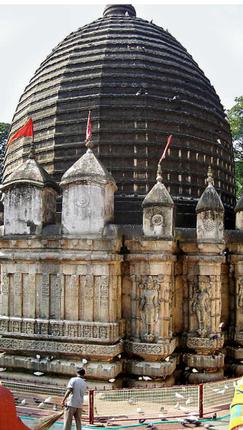Kamakhya Temple, the Pride of Nilachal

There are any number of enthusiastic tourists who trek the Himalayas and the north-east, but how many are aware that there still exist ancient, pre-Aryan practices and modes of worship which are mystical and highly evolved?
The Nilachal range of hills in the upper Assam-Guwahati to be precise — is home to a potent, feminine force called Kamakhya who is looked upon as mother goddess, a concept that denies Aryanisation. Its origin can be traced to the reverence of creative energy — by the earliest civilisations that believed in Nature worship — which is obviously vested in female form. To the ancients, creation of life through motherhood was itself a mind-boggling wonder which they deified through concrete structures which were metaphors of fertility cult. This was a universal phenomenon across all primeval civilisations and not just confined to India alone. Yogic practices and powers which of late have come into vogue, are related to the awakening of energy centres (Arthur Avalon’s The Serpent Power ) corresponding to vital points (plexuses) in the nervous system that runs through the spinal column, to put it simply. These have become time-tested through the ages, through the rishis/monks who have left behind a legacy in the form of the written word as also trained disciples who in turn passed it on to a few credible souls that are still in and around the present day world (not to talk of imposters), for most part unknown or unpublicised.
What is mysterious about the precincts of Kamakhya temple is the location of the deities, which only a sensitive tourist can appreciate. Firstly, it is not the sort of pilgrimage which most of us envisage; there is no deity as such that resembles the human form in stone like most of the temples. What more, the goddess as she is called, is not visible to the naked eye; she has to be felt rather than seen. A meandering drive on the hill and you got to trek the rugged stone stairs leading to the temple proper. Well, not all is done. From there begins your weird journey through narrow, dark chambers with only walls scratching against your elbows. You literally shove your way into a vault where in the semi-lit darkness you find a pool of water enveloped on all four sides by a cemented stone boundary and then you kneel down gingerly on that structure to run your hand within the water to a stone edifice that is more than a foot and half deep into the water, on being directed by the priest. That is Devi Kamakhya for you! She is in the form of ‘meru’ (holy yoni) and is supposed to be residing in the Swadishtana chakra (the second plexus from the sacral gland). Since the entire concept is enveloped in secrecy- you are told that she is unseen, underground and in water! For most tourists, other than Bengalis or Assamese, it makes no sense. And many of them are unaware that there are similar edifices which are proclaimed in ancient Tantric texts as potent forces, often meditated upon by rishis to gain supernatural powers. And these are the ‘Dasha Mahavidyas’ (10 goddesses), a pantheon of goddesses that existed way prior to Aryanisation and Hinduism. Each ‘vidya’ is located at a walkable distance to the main temple but then involves an arduous trek uphill or downhills with precarious stone stairs. And what more, all are placed in water ponds deep down in dark chambers lit with earthen lamps placed by devotees who take care to visit the shrine. These are Matangi, Kamalathmika, (just next to Kamakhya Devi), and then outside the temple premises we have Tara, Kali, Chinnamastha, Boglamukhi, Bhuvaneshwari, Dhumavathi, Shodashi and Tripura Bhairavi. Of these, Chinnamastha is the most dangerous to traverse since the stairs leading to the sanctum sanctorum fall from under your feet like a ladder to a depth you cannot gauge, not to talk of pitch dark environs. The devotees can get in and out of these shrines and do their own worship with or without a priest to officiate. The turbulent Brahmaputra River that runs right in the middle of the city houses a grove in its central waters where yet another shrine (Umananda) is tucked away on a hillock and the same procedure is repeated to reach the sanctum. You can reach this lovely hillock which is home to white monkeys, through the ferry service that is regularly available.







